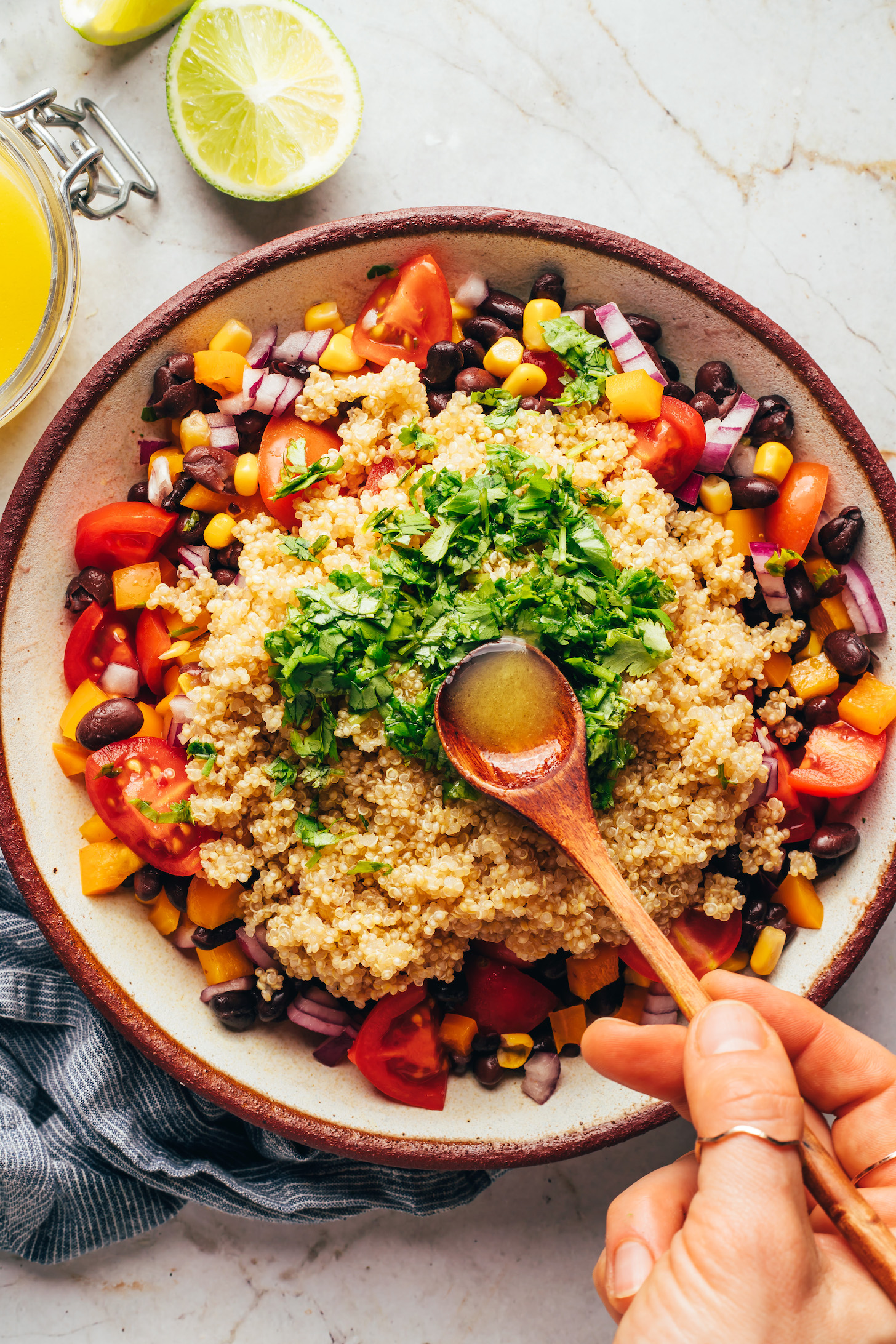
Whether you’re a party person, a meal prepper, or a picnic lover, we’ve got a salad that can do it ALL! This fresh, crunchy Southwest-inspired quinoa salad features corn, black beans, cilantro, tons of veggies, and a zippy lime vinaigrette. BIG TIME deliciousness, friends!
It keeps well, making it perfect for BBQs, picnics, or quick lunches throughout the week. Simple ingredients and just 30 minutes required! Let us show you how it’s done!

How to Make Black Bean Quinoa Salad
This SIMPLE black bean and quinoa salad begins with: quinoa! We often have this nutrient-packed pseudo-grain (it’s actually a seed) cooked and ready to go in our fridge, whether we’re using it to make breakfast cookies, fritters, stir-fries, or power bowls.
For this salad, you can use quinoa that you’ve made ahead, or make a fresh batch when ready to make the salad. Quinoa cooks in about 15 minutes on the stovetop and is also very easy to make in the Instant Pot (a great option for beating summertime heat!).

Next, we chop up fresh, crunchy veggies (cherry tomatoes + bell pepper + red onion) and add corn for sweetness and cilantro for an herby touch. If you don’t like cilantro, you could leave it out or try fresh dill and/or parsley.
Then it’s on to the other main component of this salad: black beans! They boost the fiber and protein content, making this salad quite the nutrient powerhouse.

The final component is the lime vinaigrette, made with lime juice, olive oil, maple syrup, and sea salt. To keep things super simple and ensure a 1-bowl, 30-minute situation (once your quinoa is made), we add the dressing ingredients directly into the salad and give it a stir.
After that, it’s ready to enjoy right away on its own…or topped with avocado and pepitas to make it extra filling.

We hope you LOVE this quinoa black bean salad! It’s:
Fresh
Crunchy
Herby
Veggie-packed
Meal prep-friendly
& SO delicious!
This protein and fiber-packed side is a great make-ahead dish for summer picnics and BBQs, lunches throughout the week, or when it’s too hot to cook!
More Grain & Bean Salads
- Lemony White Bean Quinoa Salad
- Mediterranean-Inspired Orzo Pasta Salad
- Easy Three Bean Salad
- Rainbow Quinoa Salad with Chili Garlic Sesame Dressing
If you try this recipe, let us know! Leave a comment, rate it, and don’t forget to tag a photo @minimalistbaker on Instagram. Cheers, friends!

Simple Quinoa Black Bean Salad
Ingredients
- 2 ½ cups cooked and cooled quinoa (3/4 cup or 138 g dry quinoa yields ~2 ½ cups or 460 g cooked)
- 2 cups cherry tomatoes, quartered (1 pint yields ~2 cups or 315 g)
- 1 cup orange or red bell pepper, finely diced (1 medium bell pepper yields ~ 1 cup or 115 g)
- 1/3 cup finely diced red onion (1/2 small onion yields ~1/3 cup or 50 g)
- 1 (15-oz) can black beans, drained and rinsed (or ~1 ½ cups homemade)
- 3 ears fresh corn*, kernels removed (3 ears yield ~1 ½ cups or 225 g corn kernels // or sub 1 ½ cups frozen corn, thawed)
- 1/2 cup finely chopped cilantro
- 4-5 Tbsp lime juice (2-3 limes yield ~4-5 Tbsp or 60-75 ml juice, depending on how juicy they are)
- 2 Tbsp olive oil
- 2 tsp maple syrup (or honey if not vegan)
- 1 ¼ tsp sea salt (adjust to taste)
FOR SERVING optional
- 1 medium avocado, finely diced
- 1/4 cup pepitas (or our Chili Lime Roasted Pepitas!)
Instructions
- If you don’t already have cooked quinoa, prepare it at this time. In a small saucepan, combine 3/4 cup (138 g) dry quinoa and 1 ½ cups (360 ml) water (this will make ~2 ½ cups cooked quinoa — adjust amounts if altering default number of servings). Bring to a boil over medium-high heat. Once boiling, reduce heat to a simmer, cover, and continue cooking for ~12-15 minutes until the water is absorbed and the quinoa is fluffy and has expanded. Remove from the heat, stir, and set aside (covered). The quinoa will get even fluffier as it sits!
- In a large mixing bowl, combine the cherry tomatoes, bell pepper, red onion, drained and rinsed black beans, corn, and cilantro. Toss to combine.
- Add the cooked and cooled quinoa (it’s okay if it’s not completely cooled) along with the lime juice, olive oil, maple syrup, and salt and mix well. Taste and adjust as needed, adding more salt for overall flavor, lime juice for brightness, olive oil for richness, maple syrup for sweetness, or cilantro for herbiness.
- Serve at room temperature or chilled. Optionally, garnish individual servings with diced avocado and pepitas. Leftover salad (without avocado/pepitas) keeps well in a sealed container in the refrigerator for up to 2-3 days. Not freezer friendly.
Video
Notes
*Prep time/total time assumes the quinoa is already prepared. Making the quinoa will add an additional ~15 minutes.
*Nutrition information is a rough estimate calculated without optional ingredients.








Jenn O. says
Delicious, nutritious, quick, and easy to modify! I added 1 cup of finely chopped Kale and a jalapeño. Thank you so much! This is going into my lunch meal prep rotation for sure.
Amazing! Thanks so much for sharing, Jenn! xo
Amy Poncy says
This is officially my favorite salad! The dressing is awesome and tasty! I omitted the quinoa. It doesn’t really need it. Added a little Santa Fe style tortilla strips for some extra kick. Just delicious!
Yum, your variation sounds amazing, Amy! Thank you for sharing! xo
Mackenzie King says
This was lovely! Super easy to put together and feed to a crowd. I’m adding some air fried tofu + avocado to the leftovers for lunch. The addition of pepitas is great too!
We’re so glad you enjoyed it, Mackenzie! Your lunch sounds lovely :) Thank you for sharing! xo
N says
I tried making this without cilantro (taste like soap to me unfortunately) and it definitely felt like it was missing an element because of that. I tried adding various things (separately) and nothing quite fit. Garlic powder was off putting, tahini was too dominant you lost all other flavors, vinegar made it smell bad (taste wasn’t especially good either), and the best I found was adding some cumin but still didn’t really seem quite right. I thought about using parsley, as many use it to substitute for cilantro, but I tend to think that’s a substitute for color as I don’t get much flavor from parsley myself.
Any ideas for how to replace cilantro?
Hi, sorry to hear you didn’t love it without the cilantro. Parsley would be the next best option, but it won’t be quite the same!
Sarah says
If I don’t have limes can I use something else?
Hi Sarah, if you have lemons, that could also work!
Ave Maria says
Sooo good! Took a chance on making it for the first time to bring to a church picnic. Makes a huge amount! I chose this recipe because I had all the ingredients on hand, and I was very curious about using maple syrup in the dressing. Even my meat-and-potatoes hubby liked it! I have one small suggestion which worked for me: Instead of adding each dressing ingredient directly to the salad, I put all the dressing ingredients in a small bowl and whisked them together, then poured the dressing into the salad and stirred. The dressing emulsified beautifully. And this way gave me a chance to check the dressing’s flavor so I could tweak it to taste. I’ll definitely be making this again this summer! Thank you for this wonderful recipe!
We’re so glad you and your husband both enjoyed it, Ave! Thank you for the lovely review and for sharing your modification! xo
Jenn O. says
I did the same thing and also recommend!
Trish says
Hi, I just made this and it’s absolutely delicious. It did make quite a lot though, so I’m wondering if leftovers will freeze ok?
Hi Trish! So glad you enjoyed it. Thanks so much for the lovely review. However, we wouldn’t suggest freezing this one.
Trish says
Thank you, I actually brought the leftovers to a BBQ and everyone enjoyed it! Will definitely make again :)
Amazing! So glad they enjoyed it as well!
Jackie says
This was 10/10 delicious! I did use canned corn because that’s what I had and it was still amazing. My boyfriend doesn’t like cilantro so I kept a serving out for him without and he still loved it! I took my left overs to work with some air fried tofu to make it a meal and I all but inhaled it! I’m making it for a side for a graduation party I’m throwing this weekend. This will be on repeat all summer.
Yay! We’re so glad you both enjoyed it and that you’ll be making the recipe all summer. Thank you for sharing, Jackie! xo
Julia says
I really enjoyed this, so simple but so yummy!
Yay! Thank you for the lovely review, Julia! xo
Kmbfs says
Tasty salad! I don’t like corn so I swapped for cucumber. Could use more lime juice I think.
We’re glad you enjoyed it. Thank you for sharing! xo
Emma Petersson says
Oh my god how delicious 😋 this I will defenitely do many times this summer ❤️
Yay! We’re so glad this one will be on repeat in your kitchen. Thank you for the lovely review, Emma! xo
The Vegan Goddess says
Wow, this is a wonderful Southwestern salad! It’s great for warmer weather — refreshingly light and tasty. But, it’s great any time of the year and would be a nice addition to a cookout or a party.
It’s easy to make and great with avocado. More proof that something so healthy and packed with protein can be delicious.
I will enjoy leftovers for days. I stored the dressing separately to drizzle on with each meal.
I love Mexican food and this salad combines the best of it minus cheese, keeping it vegan and healthier.
Yay! We’re so glad you enjoy this salad. Thank you for the helpful and thoughtful review! xo
Denise Barton says
Should the fresh corn be cooked?
Nope! There’s no need to cook it. Just cut it off the cob and add it to the salad. Enjoy!
Elizabeth Ryan says
Do I cook the corn?
Nope! There’s no need to cook it. Just cut it off the cob and add it to the salad. Enjoy!